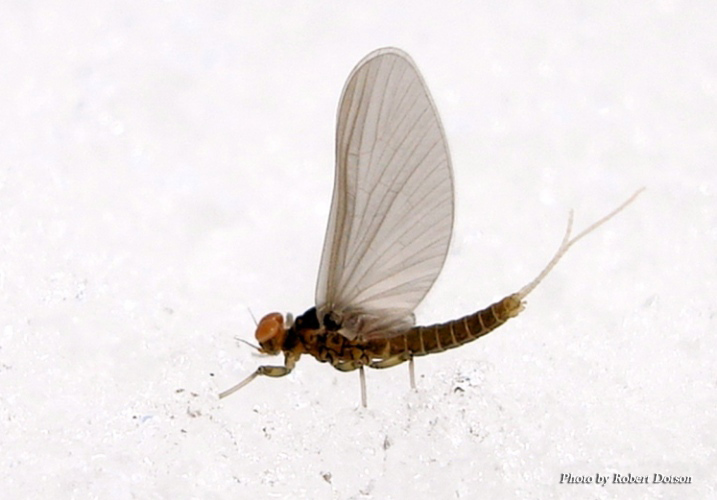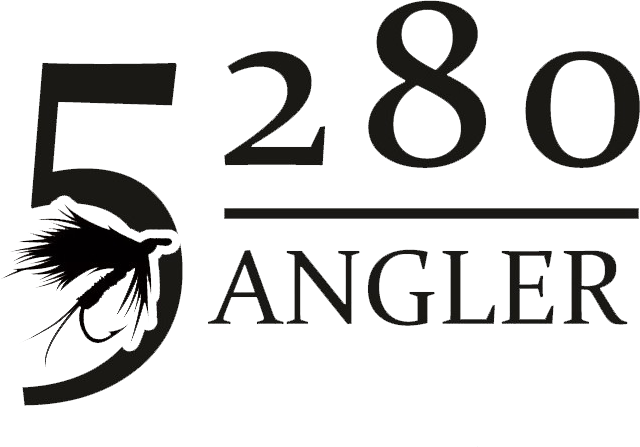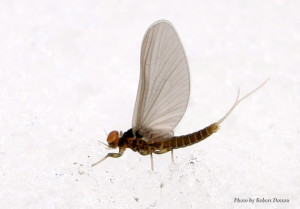
This month’s article will focus on two South Platte favorites, the RS-II created by Rim Chung back in the 1970’s, (RS II is short for “Rim’s Semblance 2”) and that fabulous creation of John Barr’s, the “Barr’s BWO Emerger”.
Both the RS II, and the Barr Emerger, are imitations of the Emerging Baetis Mayfly…or, more commonly known as the Blue Winged Olive. I selected these flies this month because as the river starts to warm up we should start to see increased Blue Winged Olive activity.
The RS II and the Barr Emerger represent the emerger phase of the Blue Wing Olive. The emerging phase of the BWO nymph is a critical phase of its lifecycle, even though it represents the shortest life cycle phase of the insect.
It is during this phase of the insect’s lifecycle that it is most vulnerable, as the emerger makes its way to the surface to split the nymphal shuck and emerge as a BWO Dun. The insect is completely helpless as it rests just under the surface film of the water…easy pickings for a hungry trout. Also, when the nymph starts to swim up from its bottom environment to the surface, it is at the mercy of the current, exposed and easy pickings for any hungry trout on the prowl.
Emerger patterns are typically fished to trout that are subsurface feeding. One easy way to tell if fish are subsurface feeding is by flashing. When a trout takes an insect out of the drift they often roll slightly to the side. As they do this, any ambient light will reflect off the fish’s side…thus, we see the brief mirror flash. We may also see the white of the fish’s mouth as they open their mouths to feed. Another way to tell if the fish is feeding on emergers is by the rise form at the surface. Trout taking emergers, caddis pupa, and midge pupa will porpoise on the surface, or you will see a surface disturbance but the fish doesn’t actually break the surface…this will tell you that they are taking emergers, or pupa, right under the surface and not further down in the water column. You need to know if the fish are on midge pupa, caddis pupa or mayfly emergers. Be sure you measure the drift or observe the water and determine what is coming up.
Okay, so when to fish these emergers? Once you get to your favorite water, do a stream sample and see what is in the drift, if you know that the BWO’s have been coming off the water at a certain time of day, you can start off prospecting before the hatch with a Pheasant Tail as your point fly and an RS-II or Barr’s Emerger (for example) as the dropper. Once you start to see some surface action, but aren’t sure what the rise forms represent, I would switch to a Parachute Adams, or Parachute BWO, as my point fly with the emerger dropped off behind it. Once you are certain that the fish are on duns, you can switch to a single or tandem dry fly rig.
Just a note: fish are finicky…and, at best, unpredictable, so you can’t always go with what the authors put in print. You need to get out and do your own experimentation…trial & error, pay your dues so to speak. It is common knowledge that the main staple of a trout’s diet during the lean winter months is the midge. There hasn’t been a BWO seen in weeks…yet, there you are catching trout on a #22 or #24 RS-II in the middle of the winter…it happens, more frequently than you know. So, don’t be afraid to try something outside of the box.
So let’s look at two Blue Wing Olive Emerger imitations, the RS-II and the Barr Emerger (BWO). There are many variations of the RS-II, such as the mercury bead head, and the flashback versions but I will present the standard version and you can experiment on your own with other iterations.
BARR Emerger BWO
Hook: TMC 2487 or 2488 (H) #16-24 Thread: 8/0 Iron Dun Tail: Brown Spade Hackle Fibers Abdomen: Olive Brown SuperFine Dubbing Wingcase: Dark Dun Spade Hackle Fibers Thorax: Grey Muskrat or Beaver Dubbing Legs: Leftover tips of wingcase fibers
RS-II
Hook: TMC 101 or 100 #16-24 Thread: 8/0 Gray Tails: Two white or dun Microfibetts Abdomen: Adams Gray Superfine dubbing, grey beaver or muskrat dubbing Wing: Bright White Antron Yarn Thorax: Adams Gray Superfine dubbing, grey beaver or muskrat dubbing.
**Credits: The photo’s and pattern recipe’s provided in this month’s newsletter article were from Charlie’s Fly Box at www.charliesflyboxinc.com there are a number of very useful patterns and tutorials.



